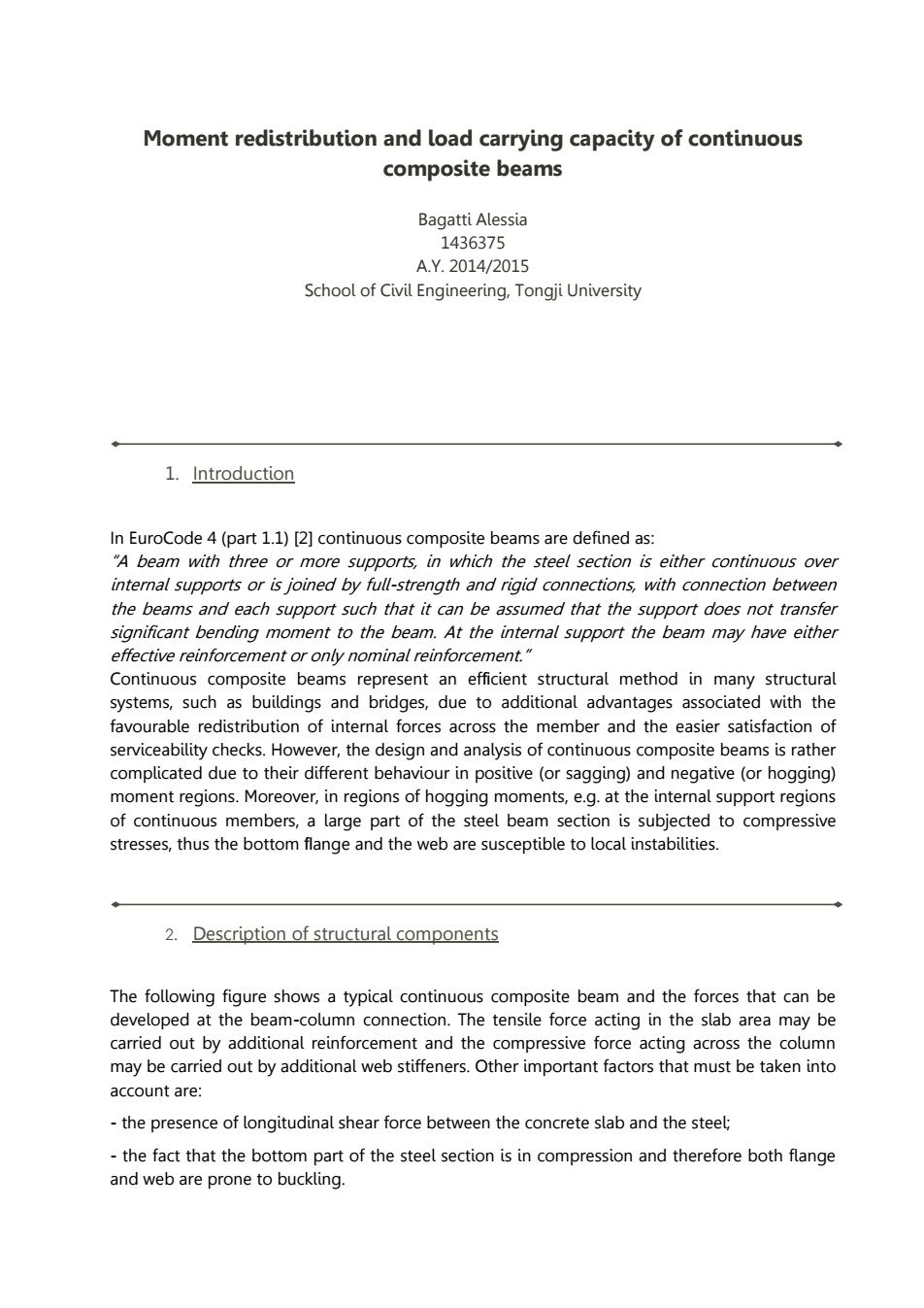正在加载图片...

Moment redistribution and load carrying capacity of continuous composite beams Bagatti Alessia 1436375 A.Y.2014/2015 School of Civil Engineering,Tongji University 1.Introduction n EuroCode 4(part 1.1)[2]continuous composite beams are defined as internal supports or is joined by full-strength and rigid connections,with connection between the beams and each support such that it can be assumed that the support does not transfer significant bending moment to the beam.At the internal support the beam may have either effective reinforcement or only nominal reinforcement." Continuous composite beams represent an efficient structural method in many structural systems,such as buildings and bridges,due to additional advantages associated with the dis th n easier serviceability chec owever,the de esign and analysis of continuous composite beams is rathe complicated due to their different behaviour in positive(or sagging)and negative(or hogging) moment regions.Moreover,in regions of hogging moments,e.g.at the internal support regions of continuous members,a large part of the steel beam section is subjected to compressive stresses,thus the bottom flange and the web are susceptible to local instabilities. 2.Description of structural components The following figure shows a typical continuous composite beam and the forces that can be developed at the beam-column connection.The tensile force acting in the slab area may be carried out by additional reinforcement and the compressive force acting across the column may be carried out by additional web stiffeners.Other important factors that must be taken into account are: -the presence of longitudinal shear force between the concrete slab and the steel -the fact that the bottom part of the steel section is in compression and therefore both flange and web are prone to buckling.Moment redistribution and load carrying capacity of continuous composite beams Bagatti Alessia 1436375 A.Y. 2014/2015 School of Civil Engineering, Tongji University 1. Introduction In EuroCode 4 (part 1.1) [2] continuous composite beams are defined as: “A beam with three or more supports, in which the steel section is either continuous over internal supports or is joined by full-strength and rigid connections, with connection between the beams and each support such that it can be assumed that the support does not transfer significant bending moment to the beam. At the internal support the beam may have either effective reinforcement or only nominal reinforcement.” Continuous composite beams represent an efficient structural method in many structural systems, such as buildings and bridges, due to additional advantages associated with the favourable redistribution of internal forces across the member and the easier satisfaction of serviceability checks. However, the design and analysis of continuous composite beams is rather complicated due to their different behaviour in positive (or sagging) and negative (or hogging) moment regions. Moreover, in regions of hogging moments, e.g. at the internal support regions of continuous members, a large part of the steel beam section is subjected to compressive stresses, thus the bottom flange and the web are susceptible to local instabilities. 2. Description of structural components The following figure shows a typical continuous composite beam and the forces that can be developed at the beam-column connection. The tensile force acting in the slab area may be carried out by additional reinforcement and the compressive force acting across the column may be carried out by additional web stiffeners. Other important factors that must be taken into account are: - the presence of longitudinal shear force between the concrete slab and the steel; - the fact that the bottom part of the steel section is in compression and therefore both flange and web are prone to buckling